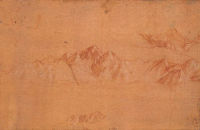The Body of Earth Click on the thumbnails to explore the trail
Read more about this trail (expand)
In his vision of the world, Leonardo saw the planet earth as a living entity, with all of its elements in a constant state of flux. As in nature form follows function, the landscape and all of its elements is seen as a product of the effects of nature that illustrates the bodily mechanisms of the earth.

- Enlarge
- The Royal Collection © 2005, Her Majesty Queen Elizabeth II
Drawing of mountains c1511
According to Leonardo, mountains were the most visible manifestation of the formation of the earth.
In this study, he faithfully records a range of mountain peaks, probably the Alps, during an expedition to the mountains dividing France and Italy mentioned in the Leicester Codex. The mountains are partly covered with snow, and the light strikes them from the right.
Leonardo’s observation of layers of fossils in mountains high above sea level provided the basis for his theory on the origin and formation of the landscape. Historically, deposits of fossils were thought to have been laid down by the Biblical flood. Leonardo noted that fossils were too heavy to float, which meant that they could not have been carried to high ground by flood waters.
Furthermore, observing how in places there was more than one layer of fossils, he concluded that such phenomena could not be the result of a single event, but rather evidence of a repeated action on the part of nature. This led to the theory that the landscape was formed by continuous and repeated flooding and the erosive powers of water.
In Leonardo's words
The lower contours of distant objects will be less discernible than their upper boundaries, and this occurs especially with mountains and hills.
- Medium Red chalk, heightened with white, on brick-red prepared paper
- Size 10.5 x 16 cm
- Location The Royal Collection










